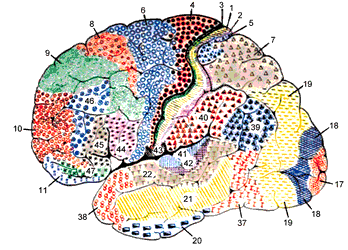Ventral primary motor cortex¶
This chapter covers the last step in the cortical hierarchy of speech production, the ventral aspect of primary motor cortex:

It is red dots indicating BA 4 in the colorized version of Brodmann’s map of the left hemisphere and the blue area in [Dum14]’s image of the left hemisphere:


The little men¶
One of the most surprising facts to emerge from modern studies of the brain is the discovery of leprechauns. Leprechauns! You think that I am kidding, but consider this:

Fig. 122 Front view of sensory homunculus sculpted by Sharon Price-Jones. [1]¶
OK, leprechauns wear clothes – green clothes, at least while they are at work.
Question
So assume that this is not the sculptress’ artistic license but rather an accurate rendition of some aspect of how the brain represents the body. What could it be?
In the 1930s, Roger Penfield was experimenting with treating epilepsy by destroying the areas of the brain where a seizure originates. As you can imagine, this is an extremely dangerous operation, only done as a last resort when the disease has progressed so far that the patient will die if nothing is done.
It involves a craniotomy, the removal of part of the skull in order to reveal the living brain. Human craniotomy is usually performed under general anesthesia but can be also done with the patient awake using a local anesthetic and generally does not involve significant discomfort for the patient.
Question
What? How can cutting off a piece of the skull not involve “significant discomfort for the patient”?
If the patient is conscious, the surgeon can ask her questions about what she perceives. Penfield would apply a small electric shock to the cortex and ask the patient what she felt. In this way, he could try to avoid cutting away ‘important’ parts of the cortex. Gradually, he and his colleagues mapped out the functions of the cortex. They discovered that the primary motor and somatosensory or ‘touch’ areas of the cortex are laid out like the body, with the feet at the top, down in the central sulcus, and the lips, tongue and pharynx at the bottom, on the edge of the lateral sulcus or Sylvian fissure. They illustrated their results with a diagram like the following, which is one of the most famous in neuroscience:

A single one is called a homunculus, Latin for “little man”. Its plural is homunculi, which saves you from having to try to pronounce ‘homunculuses’.
Task
The motor homunculus of the primary motor cortex is found in the precentral gyrus, BA 4. The somatosensory homunculus of the primary somatosensory cortex is found in the postcentral gyrus, BA 1-3. Go back over the previous images to find these areas.
Question
Do the two homunculi really include ALL your body parts?
Articulatory Net hypothesis¶
The ventral primary motor cortex is the last step in the articulatory net hypothesis, the place where individual phones are converted to motor commands:
Ventral primary motor cortex¶
{Vigneau et al., 2006, #88117}
The cluster straddling the upper part of the RolS closely matches the mouth primary motor area, as identified by a previous meta-analysis (Fox et al., 2001). The contrasts that correspond to this cluster included covert and overt articulation of phonemes (Bookheimer et al., 2000), syllables (Wildgruber et al., 2001), letters (Jessen et al., 1999), and pseudo-words (Riecker et al., 2000), as well as word repetition (Price et al., 1996c), and silent rehearsal of letters during working-memory tasks (Cohen et al., 1997 and Rypma et al., 1999). This area shows an asymmetry favoring left hemisphere activity, attesting to its specialization for language, and is correlated with syllable rate production (Fox et al., 2000). The fact that the leftward asymmetry decreases as the frequency of syllable production increases (Wildgruber et al., 2001) indicates a contribution to low-level aspects of speech motor control. Not only the production but also auditory discrimination of syllables (Hickok and Poeppel, 2004) activates this motor area, showing that the perception of syllables is achieved through the simulation of the motor activity necessary to produce the corresponding syllable. This hypothesis is confirmed both by a recent report showing that listening to syllables activates motor areas at the same location as RolS, which was shown to be involved during speech production in the same subjects (Wilson et al., 2004). It is also strengthened by the evidence of activation of articulation muscles during speech listening (Fadiga et al., 2002), resulting from transcranial magnetic stimulation study.
The lower precentral cluster (Prec) gathers peaks that show greater activity during phonological than semantic tasks, such as reading pseudo-words versus reading words (Herbster et al., 1997), detecting pseudo-words versus detecting words (Kotz et al., 2002), detecting rhymes versus detecting synonyms (Roskies et al., 2001), phonetic monitoring versus word and pseudo-word listening (Zatorre et al., 1992), and syllable counting versus word categorization (Poldrack et al., 1999). Because tongue (Riecker et al., 2000) and complex oro-laryngeal movements (Braun et al., 1997) also recruit this area, its involvement in phonology probably reflects the silent rehearsal component that is common to all of these tasks, as well as working-memory tasks (Bunge et al., 2001, Cohen et al., 1997, Hautzel et al., 2002, Paulesu et al., 1993 and Rypma et al., 1999).
Summary¶
References¶
Vigneau, M., Beaucousin, V., Hervé, P. Y., Duffau, H., Crivello, F., Houdé, O. et al. (2006). Meta-analyzing left hemisphere language areas: Phonology, semantics, and sentence processing. NeuroImage, 30(4), 1414-1432. https://www.sciencedirect.com/science/article/pii/S1053811905024511
Hickok, G. (2012). Computational neuroanatomy of speech production. Nature Reviews Neuroscience, 13(2), 135-145.
End notes¶
The next topic¶
The next topic is Articulation.
Last edited Aug 21, 2025